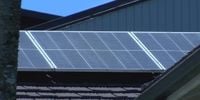The U.S. solar industry is facing a turbulent crossroads as a recent Senate amendment to the 2025 budget reconciliation bill threatens to upend the progress made under the Inflation Reduction Act (IRA) and cast a shadow over the renewable energy landscape. Passed on July 1, 2025, this legislation accelerates the phaseout of vital tax credits for solar and wind projects, imposes stringent domestic content requirements, and introduces penalties for using materials from "prohibited foreign entities." The immediate fallout has been a sharp sell-off in solar stocks and a scramble among homeowners and businesses to secure installations before the incentives vanish.
Under the new Senate amendment, tax credits for solar projects that begin construction after December 31, 2025, must be placed in service by December 31, 2027, a drastic tightening from the original 2032 deadline set by the IRA. Projects starting after July 1, 2026, face even tougher deadlines. Additionally, solar components must meet escalating U.S. content thresholds—50% by 2026 and 85% by 2030—upending established supply chains heavily reliant on foreign manufacturers, particularly those in China. Projects incorporating materials from "prohibited foreign entities" could face excise taxes or credit recapture, adding layers of compliance risk for developers operating globally.
These changes mark a stark policy pivot from the bipartisan support that had previously fueled renewable energy growth, reflecting a Republican agenda that prioritizes traditional energy sectors and national security concerns. As one analyst put it, "This isn't just a policy shift—it's a strategic pivot to reset the energy economy, and the solar sector is collateral damage." The market responded swiftly: First Solar (FSLR) saw its shares drop 14% in the week following the amendment, SunPower (SPWR) fell 11%, and Vivint Solar (VSLR) declined 9%. The broader Renewable Energy ETF (ICLN) lost 8% in July, underperforming the S&P 500 by 9 percentage points, while defense and fossil fuel stocks gained ground.
The consequences for the solar sector are multifaceted. Supply chain disruptions are expected as companies like Enphase Energy, which source components domestically, may gain an advantage over firms dependent on foreign suppliers. However, developers in regions without robust domestic manufacturing infrastructure, such as offshore wind projects, face higher costs and logistical hurdles. The accelerated deadlines create a "race to build," heightening risks of cost overruns and stranded assets if projects miss the cutoff. An industry insider warned, "This isn't just about tariffs—it's about whether the U.S. can actually build these projects fast enough." Furthermore, the emphasis on "prohibited foreign entities" could exacerbate geopolitical tensions, particularly with China. Goldman Sachs analysts estimate compliance costs could add $15 to $20 billion to the solar industry’s expenses by 2030.
For homeowners and installers, the Senate bill signals a deadline-driven rush. The legislation would end the 30% tax credit for rooftop solar and home battery storage systems after December 31, 2025, alongside a $2,000 credit for heat pumps. A $7,500 tax credit for certain electric vehicles would expire after September 30, 2025, including a loophole that allowed carmakers to extend savings to leasing customers. This has prompted a surge in demand, with some solar companies reporting tripled call volumes as homeowners hurry to secure installations before costs rise. Rocky Mould of the Hawaii Solar Energy Association emphasized, "The clock is ticking and we really do need to work expeditiously to get projects in if they want to claim that 30 percent credit." Joshua Powell, CEO of Revolusun in Hawaii, echoed the urgency: "There’s only so much we can take on and make sure that we’re going to be able to keep commitments we make to our customers. We don’t want to let anyone down when you’re facing a real deadline." However, permit delays across the Hawaiian islands complicate this process.
Despite the looming cutbacks, Hawaii maintains a state solar incentive of 35%, which some see as insufficient for low to moderate-income families who could benefit most. Chris DeBone of Hawaii Energy Connection expressed confidence that larger clean energy corporations will weather the storm, but uncertainty remains for smaller companies. Representative Diamond Garcia noted, "I think that will help our local residents, but I think the federal government right now, is trying to make sure that we are energy independent and dominant." Interestingly, the Senate bill preserves tax credits for nuclear, hydropower, and geothermal projects, favored by the Trump administration for their reliability independent of weather conditions. Notably, those who lease their solar systems will still be able to claim the credit through 2027, providing some relief.
Beyond the immediate impact on installations and consumer incentives, the bill threatens the revival of U.S. solar panel manufacturing—a sector that had begun to rebound following tariffs imposed during the first Trump administration and the generous incentives under the Biden administration’s IRA. Mike Carr, executive director of Solar Energy Manufacturers for America, which represents more than 15 companies and 6,100 manufacturing workers, warned, "This is going to put people out of business. This is going to devastate the industry." The United States, once the global leader in solar panel production through the 1990s, lost ground to countries like Japan, Germany, and ultimately China, which now dominates global solar panel and component manufacturing. Federal aid and tariffs had fostered a fragile comeback, but the recent Republican-led policy threatens to halt this momentum and cede near-total control to China.
For investors navigating this uncertain terrain, strategic caution is paramount. Hedging with inverse ETFs, focusing on companies with domestic supply chains such as Suniva and 1366 Technologies, and timing purchases around the 2026–2027 deadlines may mitigate risks. Diversification into energy storage and efficiency sectors, with companies like Tesla and Enphase Energy, could also provide opportunities, as these areas remain less affected by tax credit changes.
Ultimately, the Senate’s amendment underscores the volatility inherent in renewable energy policy and the complex interplay between national security, economic interests, and climate goals. While global demand for clean energy is projected to triple by 2030, the near-term landscape is fraught with challenges that test the resilience of the solar industry and its investors. As one energy fund manager succinctly put it, "This isn't the end of solar—it's the start of a painful reckoning." Those who navigate these turbulent waters with prudence may find opportunities amid the upheaval, but the path forward demands careful timing and a keen eye on evolving legislation.




